
Newsletter of the Shell Club of Sydney
NSW Branch, The Malacological Society of Australasia Limited ACN 067 894 848
Shell of the show
"Wow Factor" category:
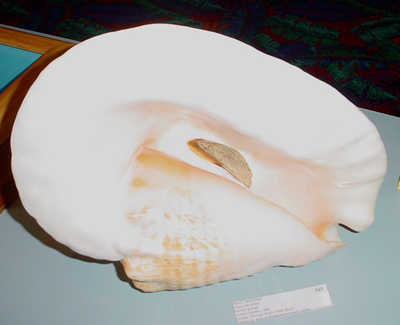
Shell of the show
normal entrants:
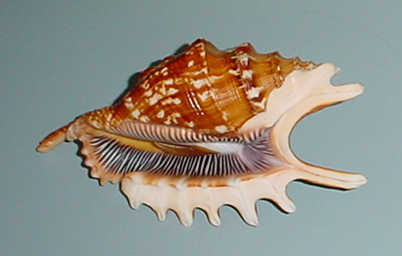
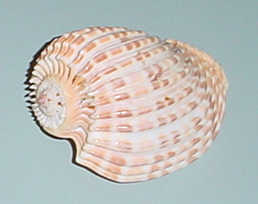 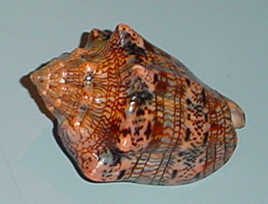
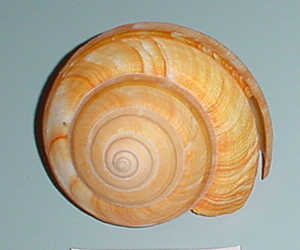
NEW SOUTH WALES BRANCH
ANNUAL SHELL SHOW RESULTS
SATURDAY 25 OCTOBER 2003
|
Categories |
Position |
Winner |
|
1. Display
of Cones
|
1st
|
Steve Dean
|
|
|
2nd
|
John Franklin
|
|
2. Display
of Cowries
|
1st
|
John Franklin
|
|
|
2nd
|
Steve Dean
|
|
|
3rd
|
Pete Dean
|
|
3. Display
of Volutes
|
1st
|
Trevor Appleton
|
|
|
2nd
|
Patty Jansen
|
|
|
3rd
|
Ashley Miskelly
|
|
|
Highly Commended
|
John Franklin
|
|
4. Display
of Ranellidae
|
1st
|
Steve Dean
|
|
|
2nd
|
Patty Jansen
|
|
5. Display
of Bi-valves
|
1st
|
Pete Dean
|
|
6. Display
of Murex
|
1st
|
Maureen Anderson
|
|
|
2nd
|
Trevor Appleton
|
|
7. Display of Favourite Shell
|
1st
|
Trevor Appleton
|
|
|
2nd
|
Sandra Montague
|
|
|
3rd
|
John Franklin
|
|
8. Shell
of the Show
|
1st
|
Maureen Anderson
”Harpa costata”
|
|
9. Shell
of the Show (WOW factor)
|
1st
|
Maureen Anderson
”Strombus goliath”
|
Ron Moylan, Show Convenor - Shell Show Overview:
Whilst the entires for the respective categories were not numerous, the quality of specimens exhibited was of an exceptional standard and a great deal of time spent preparing and presenting the exhibits was apparent.
The judges decisions in selecting the award winning entires was not an enviable task, as some serious deliberation was obvious during the judging and in some cases a single point only separating first to second to third.
In establishing the categories for the Shell Show it was the intention to reacquaint our members with their available reference material and handle specimens within their collections. Also closely examine the material proposed for the exhibits, ensuring that the species conformed with the quality to achieve a high recognition by the judges and importantly the accuracy of the accompanying data.
A most enjoyable afternoon ensued with numerous questions to the respective exhibitors about the material in their exhibits, how acquired and some serious comparisons of size and quality were also observed.
A welcome exhibitor to our Shell Show was Dr. Trevor Appleton, a member of the Brisbane Branch of the M.S.A. who entered three categories and took back to Brisbane a first in both "Volutidae" and "Display of Favourite Shells" together a second in "Muricidae". We were delighted to have Trevor with us for the afternoon and to admire his exhibits with some exceptional pieces.
It was also pleasurable to have the opportunity to view some very rare material at first hand, such as the Voluta (Nannamoria) johnclarki, a West Australian piece known from a limited number only and exhibited by John Franklin.
The "Shell of the Show" was awarded to Maureen Anderson with a stunning Harpa costata and the "Shell of the Show with WOW factor" also to Maureen with a superb specimen of Strombus goliath: approximating 355mm in length.
It is important for our club members to acquaint themselves with the judging procedures in readiness for the National Shell Show to be hosted by the New South Wales Branch in Sydney 2006.
A big thanks to Steve Dean who designed and printed the colourful certificates for the various sections, which will remain a fond memento for the recipients.
The participation of all who attended is greatly appreciated and it was encouraging to see the utilisation of the exhibit boxes from the Second National Shell Show which contributed to a uniform and most aesthetically pleasing display.
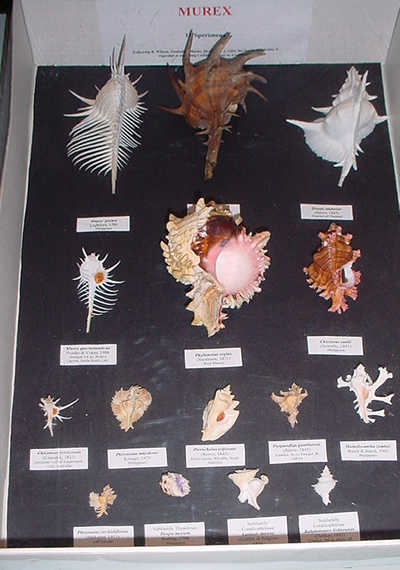
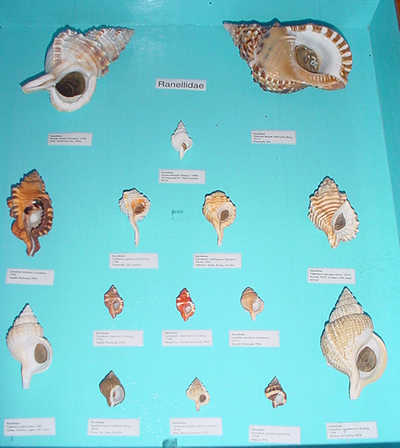
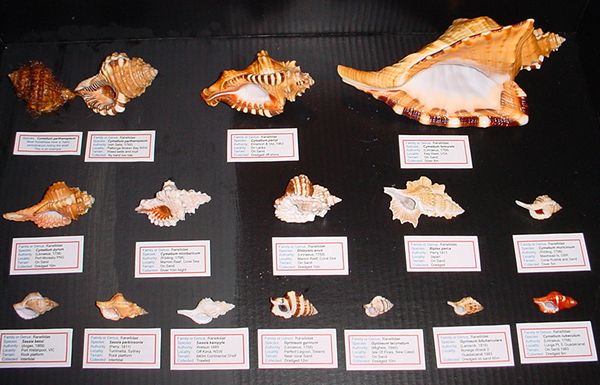
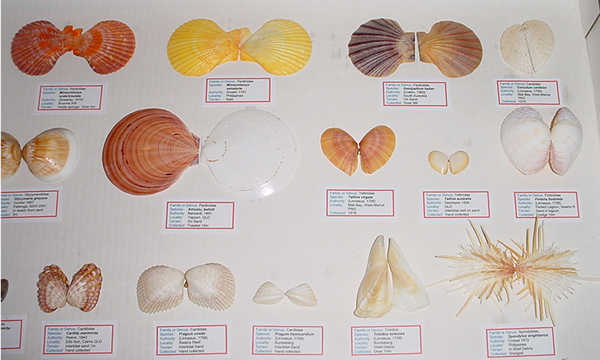
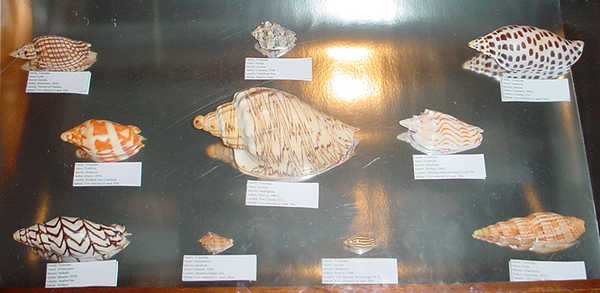
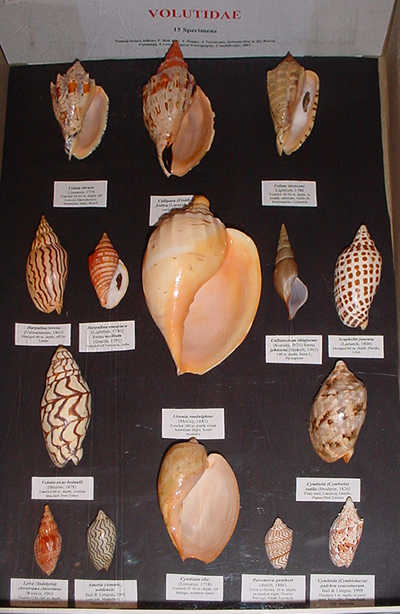
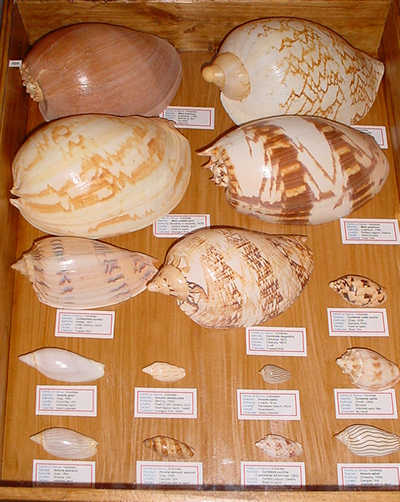
Junior Entrant
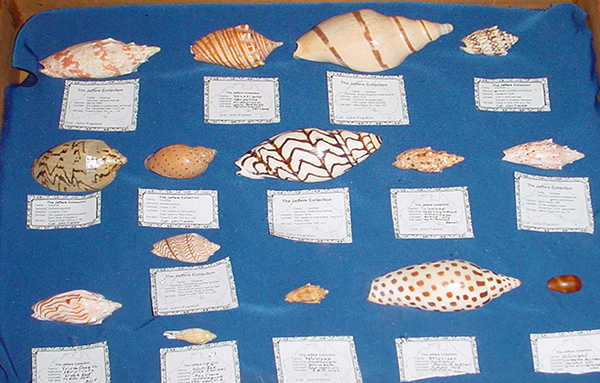
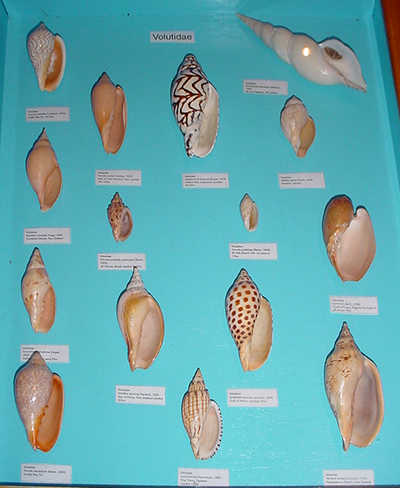
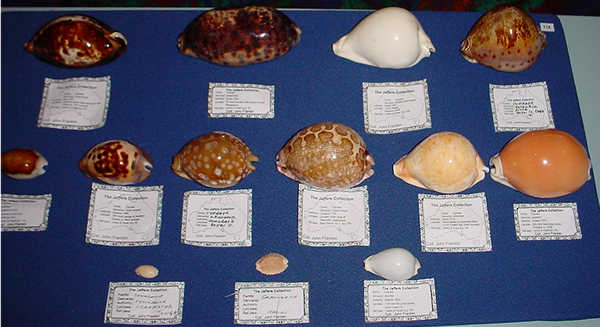
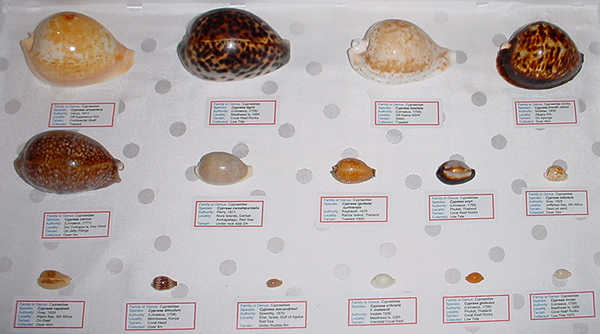
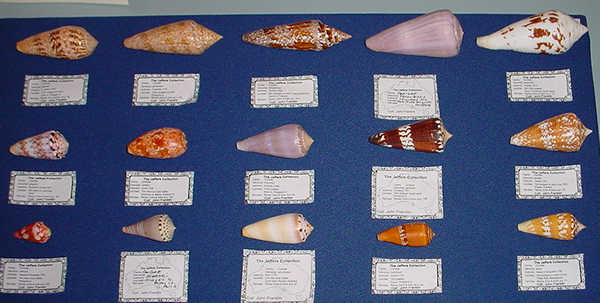
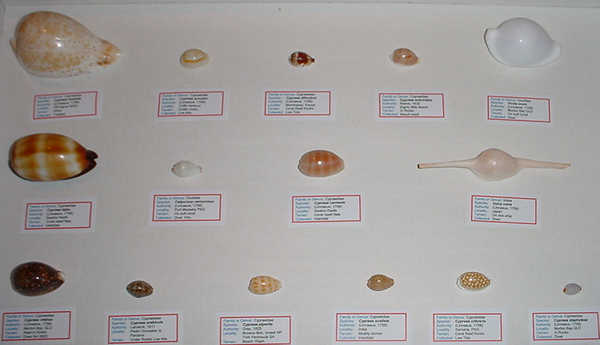
Junior Entrant
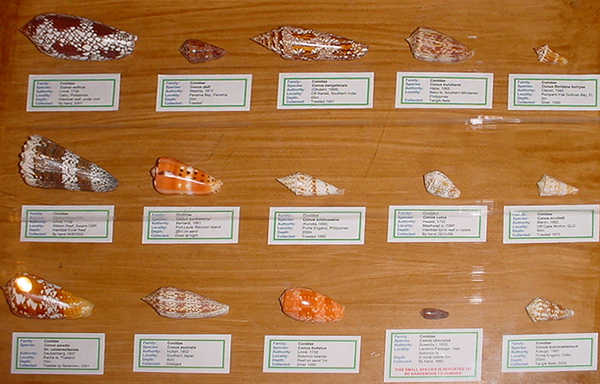
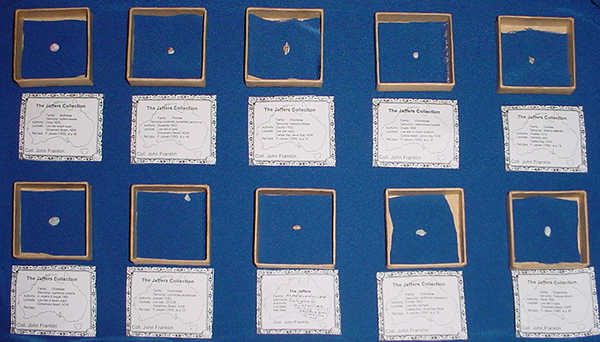
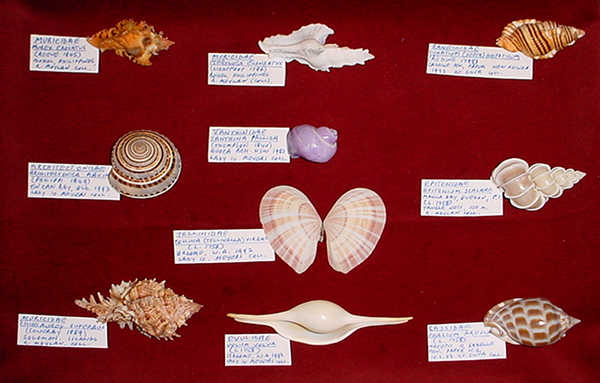
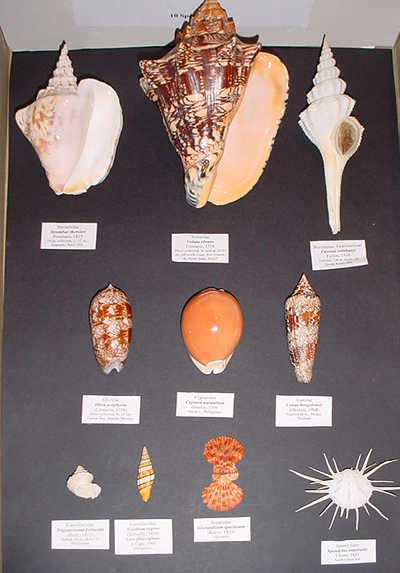
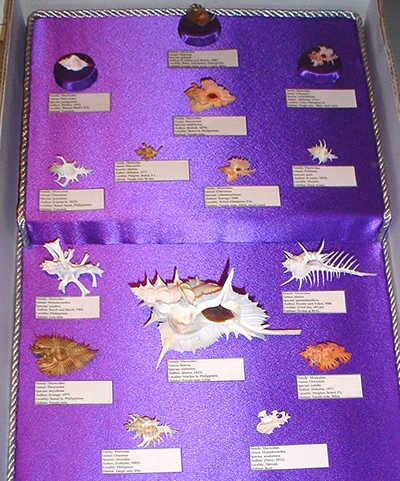
Meeting Minutes
27/09/2003.
The meeting was opened by P Jansen at 2.01 pm.
Field Trips
J. Franklin reported on a trip away to Sanur Laghawa Island near Bali. John noted there were no shell dealers although he was able to obtain some nautilus shells and enjoyed the break.
M. Keats reported that he is still going to Long Bay at Malabar once a week and by the end of December, it will have been twelve months since the beginning of his survey. Sandra has been working through shell grit from the site and a number of unusual species have been collected. Michael is working on a report to cover the surveyed material including some Marginellidae, which appear quite uncommon, even at the Australian Museum.
A. Miskelly reported still photographing specimens within Sydney harbour but has nothing new to mention.
General Business
M. Keats confirmed that Mosman council was unsuccessful in gaining funds for Chinaman's Beach research. Instead they have formed a committee and asked Michael if he is interested in joining.
Michael distributed current (Autumn 2003) copies of "Waves" & "Ripples" to the meeting.
C. Barnes tabled a letter from RELC confirming the use of a room at the club until the end of 2004. Requests are put before the club's board annually for rooms by non- profit organisations.
The October meeting is the group's annual shell show. The room will be available from 11.00am, judging will start from 2.00pm.
Presentation In place of a presentation it was decided to "brain storm" ideas and possible fund raising avenues for the proposed Sydney National Shell Show in 2006. Such things as venue suitability, requirements, floor plan, table layout and cost of dealers tables etc were discussed.
BALI 2003
John Franklin
Anticipation gave way to realisation as our plane touched down at the Ngurah Rai (Denpasar) airport Bali on Sunday afternoon the 17th August 2003.
Bali is just one rather small island in the archipelago of the Republic of Indonesia, being approximately 80 kilometres north-south and 150 kilometres at its broadest point. The island is in the equatorial belt being 8 degrees south latitude, 115 degrees east longitude and is virtually split north-south by ridges of volcanoes, the highest being Gunung (Mt.) Agung over 3000 metres high.
Overt signs of the Hindu religion flow over into the streets and footpaths, sometimes making it necessary for the tourist to step over the "offering". Spiritual "directions" have been conceived with the northerly direction being regarded as sacred and the southerly direction towards the sea, the diabolic sea. Clearly apart from commercial fishing the Balinese have little to do with the sea.
On the opposite side of the Straits west of Bali lies Java, which by ferry is only 25 minutes away. In the Ice Age Java and Bali were joined and no doubt that is why today the Strait is only 45 metres deep. To the east, the Strait of Lombok separates Lombok Island from Bali. Interestingly enough there is a deep ocean trench which constitutes the Strait with a depth of about 1325 metres.
Perhaps this deep trench is even more significant in that Alfred Wallace in the 19th century noted the differences in fauna and flora between Bali and Lombok, which is arid and a rather barren island. His theory was that there were ecological differences with Bali being the habitat, for example, of the larger mammals (tiger) and on the other hand Lombok Island being home to the marsupials, parrots and eucalypti. For him essentially the fauna and flora of Bali could be called Asian whilst the plants and animals of Lombok Island could be classified as Australasian on biological grounds. This division was called the Wallace line but subsequently it has been argued that both Bali and Lombok Island are actually in a species transition zone, called "Wallacea".
Whilst the texts generally cover the habitats of Molluscs from the West Indo Pacific, it appears that more precise research is required in order to establish any differences particularly with regard to shells whose habitat is Lombok Island.
Essentially during our stay we investigated only two areas for shells, namely Seminyak Beach (grey, fine sand) and Sanur Beach (yellow sand) but rather dirty. Whilst having dinner one evening at a restaurant, "The Tebar" located on the beach at Jimbaran Bay, a quick walk revealed a surprising amount of material.
Currently lists of material observed are being prepared, however, it certainly appears that Bali is worth a second visit with more time allowed for research.
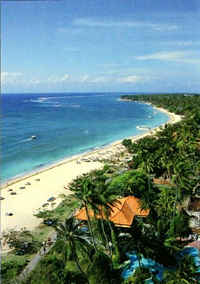 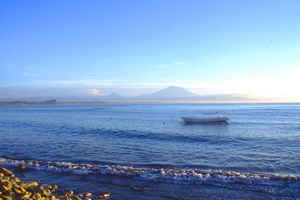 Sanur Beach
Sanur Beach
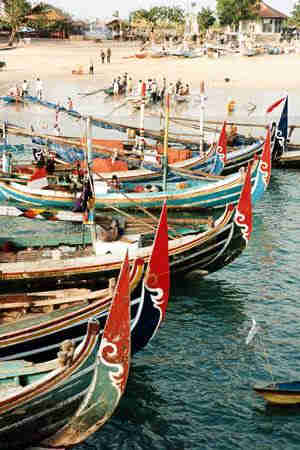 Jimbaran Bay
Jimbaran Bay
LEMBONGAN ISLAND - BALI
John Franklin

On Monday the 22nd August 2003 at 10:00 a.m. we left Benoa Harbour, Bali by a super fast jet boat for Lembongan Island just 14 miles across the Badung Strait east of Bali.
Coconut Beach Resort located on the Island is a tourist favourite offering accommodation, snorkelling, diving, kayaking and the use of a semi submarine underwater explorer.
The beautiful Jungut Batu Village overlooks the Badung Strait. Standing on the beach below the village, looking in a northerly direction, one firstly notices seaweed beds close to shore then waves breaking on the reef about a kilometre away from the shoreline. Local and international surfers practise their skills on these breaks.
Turning then slightly to the northeast there arises in the distance, across the Strait of Lombok, Bali's highest volcano, the magnificent Gunung (Mt.) Agung with its peak piercing the misty white-purple clouds.
Finally, further to the northeast there is a promontory projecting into the Strait upon which is built, in a rather dense fashion, small huts/houses extending along the sandy shoreline to the point.
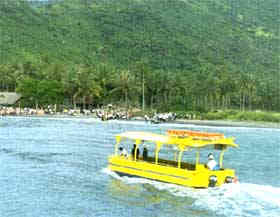
One fascinating feature of the island is seaweed farming. An observer can sit for hours watching women carrying baskets of wet seaweed on their heads ascending from a depth of about a metre up to the shore, across the beach and then delivering their load to a central hut. The seaweed is left to dry in the sun on mats. Seaweed farming involves a great deal of activity as the men were mainly involved in gathering the material and placing it in bundles on canoes from which it can be easily collected by the women and put in carry baskets. The farming area was rather small but not unlike a wheat farm with precise boundaries, all adjacent to each other. Some men were also involved in replanting the seaweed for the next crop. The dried product is exported to Singapore, where it is used in making sweets.
Unfortunately the water on the reef was not really clear but observations revealed:
Fish Species of Lembongan Island:
Blue-banded Angelfish (Dygoplite diacanthus)
Blue Spotted Fantail Ray (Taeniura lymina)
Butterfly Fish (Chaetodon aureofasciatus)
Clouded Wrasse (Italichoeres nebulosus)
Clown Fish (Amphiprion percula)
Double Ended Pipe Fish (Syngnathoides biaculeatus)
Footballer (Microcanthus strigatus)
Moorish Idol (Zanclus canescens)
Ring-tailed Surgeon Fish (Acanthurus xanthopterus)
Parrot Fish (Scams rivulatus)
Saddled Coral Fish (Chaetodon ephippium)
Sea Garfish (Hyporhamphus australis)
Snakes in black and yellow colour
Squids
Stonefish (Synanceia horrida)
Travally (Caranx mobilis)
Unicorn Fish (Naso unicornis)
White and black tipped reef shark (Triaenodon apicalis)
Corals of Lembongan Island
Montipora capricornis: a rose shaped coral in various colours
Acropoia hyacinthus: colonies of wide flat tables which are thin and finely structured. Also known as "Plate Coral"
Pseudo siderastrea: also known as "Brain Corals"
Fungia refada: Circular corals up to 30cm in diameter, thick, flat or strongly arced, also called "Verillio Fungia"
Helifungia achniformis: solitary, free living and flat with a central mouth, also called "Sunfungia"
Merulina ampliata: many small plates, similar to plate corals
Acropora valenciennesi: shaped like branches, also called "Staghorn Coral"
Acropora clathrate: colonies of tables with generally horizontal radiating. Also known as "Table Coral"
Porites nigrescens: shaped as small branches, with encrusting base
Goniopora penclulus: colonies are hemispherical. Tentacles flow freely in the water.
It was indeed fortunate that accompanying us on our snorkelling adventure over the reef were some local students who had visited the reef on many previous occasions and were happy to provide us with a list of fishes and corals generally observed in the reef habitat. These lists are by no means exhaustive.
Shells of Lembongan Island:
In rather unclear conditions out on the reef we noticed:
Bivalvia: Cardiidae, Corculum cardissa
Bivalvia: Tridacnidae, Hippopushippopus Linnaeus 1758
Bivalvia: Pholadidae (monothyra) orientalis (Gmelin 1790)
Gastropoda: Conidae, Conus pulicarius, Hwass in Bruguiere 1792
Gastropoda: Ovulidae, Ovula ovum (Linnaeus 1758)
Following our arrival on Coconut Beach, in the very limited time that remained, we took the opportunity to investigate the rocks at low tide before journeying back to Benoa Harbour. Whilst there were representatives of all the major families, interestingly enough we found
Cypraea bistrenotata, Conus coronatus (Gmelin), Nassarius
bicolour, Pilosabia pilosa Deshayes and many more specimens.
As our boat began to move out of the bay one could not help noticing the beautiful beach, the seaweed farmers/gatherers working and the volcano majestically towering 3000 metres high just across the bay; what a wonderful place!
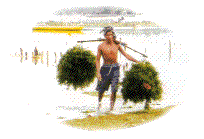
|

























 Sanur Beach
Sanur Beach
 Jimbaran Bay
Jimbaran Bay


